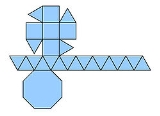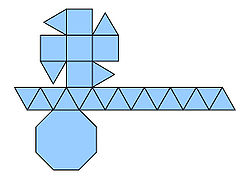
Gyroelongated square cupola
Encyclopedia


Geometry
Geometry arose as the field of knowledge dealing with spatial relationships. Geometry was one of the two fields of pre-modern mathematics, the other being the study of numbers ....
, the gyroelongated square cupola is one of the Johnson solid
Johnson solid
In geometry, a Johnson solid is a strictly convex polyhedron, each face of which is a regular polygon, but which is not uniform, i.e., not a Platonic solid, Archimedean solid, prism or antiprism. There is no requirement that each face must be the same polygon, or that the same polygons join around...
s (J23). As the name suggests, it can be constructed by gyroelongating a square cupola
Square cupola
In geometry, the square cupola, sometimes called lesser dome, is one of the Johnson solids . It can be obtained as a slice of the rhombicuboctahedron...
(J4) by attaching an octagonal antiprism
Octagonal antiprism
In geometry, the octagonal antiprism is the 6th in an infinite set of antiprisms formed by an even-numbered sequence of triangle sides closed by two polygon caps.If faces are all regular, it is a semiregular polyhedron.- See also :* Set of antiprisms...
to its base. It can also be seen as a gyroelongated square bicupola
Gyroelongated square bicupola
In geometry, the gyroelongated square bicupola is one of the Johnson solids . As the name suggests, it can be constructed by gyroelongating a square bicupola by inserting an octagonal antiprism between its congruent halves....
(J45) with one square bicupola removed.
The 92 Johnson solids were named and described by Norman Johnson in 1966.
Dual polyhedron
The dual of the gyroelongated square cupola has 25 faces: 8 kites, 4 rhombi, and 8 quadrilaterals.| Dual gyroelongated square cupola | Net of dual |
|---|---|

